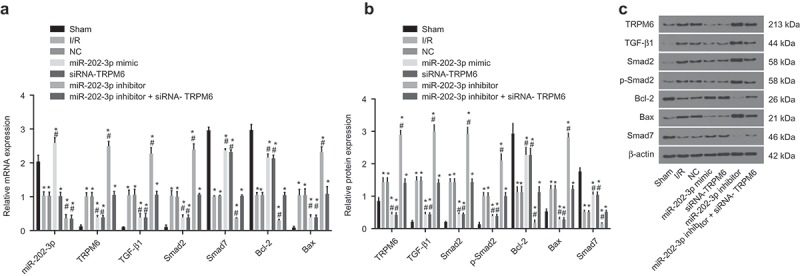Figure 7.

miR-202-3p decreases TRPM6 expression and inhibits the activation of TGF-β1/Smads signaling pathway after 4 weeks. (a) the miR-202-3p expression and mRNA levels of TRPM6, TGF-β1, Bcl-2, Bax, Smad7 and Smad2 in response to the treatment of miR-202-3p mimic, siRNA-TRPM6, miR-202-3p inhibitor or miR-202-3p inhibitor + siRNA-TRPM6; (b) the protein levels of TRPM6, TGF-β1, Bcl-2, Bax, Smad7 and Smad2 and the extent of Smad2 phosphorylation in response to the treatment of miR-202-3p mimic, siRNA-TRPM6, miR-202-3p inhibitor or miR-202-3p inhibitor + siRNA-TRPM6; (c) the gray values of TRPM6, TGF-β1, Bcl-2, Bax, Smad7, Smad2 and β-actin protein bands in response to the treatment of miR-202-3p mimic, siRNA-TRPM6, miR-202-3p inhibitor or miR-202-3p inhibitor + siRNA-TRPM6; n = 5; multiple groups were compared by one-way analysis of variance followed by a Tukey’s post hoc test; *, p < 0.05 vs. the sham group; #, p < 0.05 vs. the I/R injury group; TGF-β1, transforming growth factor, beta 1; Bcl-2, Panel B cell leukemia/lymphoma 2; Bax, BCL2-associated X protein; Smad, SMAD family; NC, negative control; mRNA, messenger RNAs; miR, microRNA; siRNA, small interfering RNA; TRPM6,transient receptor potential cation channel, subfamily M, member 6; miR-202-3p, microRNA-202-3p.
